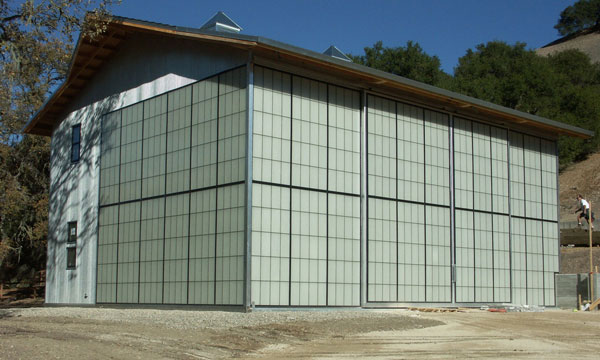 In building projects, it’s not unusual for Kalwall to be combined with recycled materials. A sustainable product itself, Kalwall contains +/- 20 percent recycled content and is a LEED® contributor. Now imagine the entire frame of a 100-year-old, New Hampshire barn taken apart, shipped to the West Coast, reassembled, and clad almost entirely in a translucent Kalwall Wall System. The result: an unusual, truly recycled, and extremely green guesthouse. That is the Duxbury Barn of Santa Ynez, California.
In building projects, it’s not unusual for Kalwall to be combined with recycled materials. A sustainable product itself, Kalwall contains +/- 20 percent recycled content and is a LEED® contributor. Now imagine the entire frame of a 100-year-old, New Hampshire barn taken apart, shipped to the West Coast, reassembled, and clad almost entirely in a translucent Kalwall Wall System. The result: an unusual, truly recycled, and extremely green guesthouse. That is the Duxbury Barn of Santa Ynez, California.
DXB-01The design by architect Carver + Schicketanz, which specializes in restoring buildings of historical interest, racked up considerable sustainability points with Santa Barbara County’s Innovative Building Review Program (IBRP). Beginning with the reuse of almost an entire building, features include recycled metal on interior walls, solar hot water and radiant heat systems, a 2,500-gallon cistern for capturing rainwater, and passive cooling (no air conditioning). Concrete components use fly ash, bathroom sinks are recycled water buckets, and a former trough is now a bar. Even new wood cabinetry is constructed sustainably and kept to a minimum by giving new life to colorful, vintage soft drink and produce crates as kitchen drawers. The IBRP offers incentives – such as an expedited Building & Safety Division review and 50% off an energy plan-check fee – to projects that attain one of three target levels.
“The Duxbury Barn far exceeded Target 1,” says principal architect Rob Carver, and the Kalwall translucent Wall System, on the structure’s north, south, and east facades, was a significant contributor. Carver chose Kalwall for its “good combination of translucency and insulation. It’s better than glass for energy savings and soft interior daylighting.” Compared with transparent glass, translucent Kalwall also “preserves privacy and security” and is more energy efficient.
Kalwall’s highly insulating properties keep the Duxbury Barn warm in winter and cool in summer, reducing energy costs. During the manufacturing process, Kalwall’s standard 2-3/4″ (70 mm), structural composite, translucent sandwich panels can be infilled with various densities of specialized, translucent insulation. Architects and designers can achieve a thermal insulation value of up to R-20 (U=0.05 Btu/hr/ft²/°F, or 0.3 W/m²K) and still cover expansive areas with translucent cladding or roofing.
The Kalwall translucent Wall System cuts down on the need for artificial lighting, too, as it bathes the entire barn – now one story plus a loft – in glare- and shadow-free, natural daylight. When lit from within at night, the building gives off a cozy, welcoming exterior glow while reducing light pollution. An intriguing skeletal effect is created as the sturdy timbers can be seen through the translucent panels. Kalwall helped a century-old, New Hampshire barn facing an uncertain future to travel 3,000 miles for its new career as a comfortable and sustainably renovated guesthouse. “It’s a great product,” says Carver. “I look forward to using Kalwall again.”
